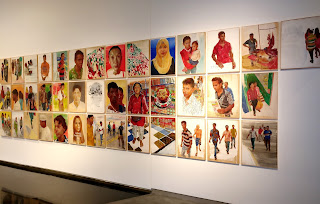Afterwork @ ILHAM
For a curatorial premise that started as about domestic migrant workers in Hong Kong, “Afterwork” does remarkably well in its Malaysian adaptation, with the inclusion of local artists and relevant programs organised during the exhibition run. For starters, the exhibits are remarkably diverse. Artist nationalities and choice of medium are moot points; Timelines and approaches in tackling the issues explored (“class, race, labour, and migration”) are multifarious, where the starting point of each individual work is worth exploring in depth. The exhibition starts strong – Gan Chin Lee’s social-realist paintings appear to be an exercise in recognizing the people and things overseen when one walks the streets of Kuala Lumpur, a reminder to re-look at one’s immediate surroundings in daily life.
 |
| Exhibition snapshot of Gan Chin Lee – Portrait Scape of Contemporary Migration (2013–2014) |
Two displays opposite evoke particularly different sentiments via its format and historical contexts. Larry Feign’s 1993 comic strip make light of the situation, when Filipino maids and dogs were banned to use residential lifts in Hong Kong’s luxury condominiums. Next to it, a looping excerpt from Little Cheung 細路祥 (2000) by Fruit Chan 陳果 shows the affection between the 9-year old protagonist and his household helper, which contrasts with the tough love dished out by his parents who run a takeaway restaurant. Entering the main exhibition area, two eye-catching works attract the visitor. Abdoulaye Konaté’s large multi-coloured swathes of worn garments depict (albeit literally) a crushed human figure, while posters and a (edited?) short film by Köken Ergun document entertainment channels for Filipino workers in Israel.
 |
| Detail snapshot of Larry Feign – The Ethnic Cleansing of Statue Square (1993) |
Given its curatorial theme, the photographic snapshot is expectedly a popular medium. The varied approached among exhibits utilizing this mode, however, dispel clichés of the photograph being a document that emphasizes the Other. From Sebastião Salgado’s forceful act of looking & meaning-making, to Alfredo Jaar’s literal ‘Fading’ of boat people (reports about stranded refugees continue to occupy the news today); Then & now juxtapositions of Hong Kong streets denoting society’s sensibilities at the time of capture, also bringing personal fame to photographers Fan Ho (1950s), and Xyza Cruz Bacani (2010s) respectively; From the sardonic interventions by Sun Yuan & Peng Yu (seeing a hand grenade in a home interior is no laughing matter), to the documented performances of Liliana Angulo and Melati Suryodarmo; How each work relates to work and the worker, is dramatically different and exciting to observe.
 |
| Exhibition snapshot of wall displaying photographs by Fan Ho |
Looking at Miljohn Ruperto’s homage to a Filipino actress who did not make it in 1940s Hollywood, this pursuit of visible work contrasts significantly with Daniela Ortiz’s collection of pictures from social media. Happy photographs of family & friends include cropped-out domestic helpers, the slideshow effectively depicting invisible work. Expected behaviours are portrayed in a video footage of interviewees practicing pre-set dialogue, while Imelda Cajipe Endaya’s figurative sculpture composed of found objects stand quietly in one corner, ever ready to present itself to the overwhelmed gallery visitor. Non-representational works appear less relevant in this exhibition’s context; the inclusion of vivid abstract paintings by I Gusti Ayu Kadek Murniasih, is probably to satisfy the Malaysian audience who prefers paintings?
In another awkward presentation, posters decrying violence against women by Taring Padi are displayed lying in an acrylic box, thereby relegating pressing messages into archival documents. Perhaps it belongs together with other exhibits at this end of the gallery, that refer to historical associations of social hierarchy with menial labour. Walking past reproductions of paintings, a curatorial masterstroke takes the form of a small screen looping eight advertisements from Hong Kong, Thailand, and Malaysia. Stereotypes of migrant workers – darker skin, coming from different cultures, but possess a willingness to adapt – are shamelessly portrayed, the videos implying the propagation of a non-colonial master-slave dynamic that has evolved in this part of the world.
 |
| Lai Loong Sung – Refugees (1979) |
Besides infusing local relevance, the Malaysian works expand upon the exhibition’s curatorial themes too. Lai Loong Sung’s powerful woodcut print ‘Refugees’ project an empathy not present in other works of the same topic. ‘MA=FIL=INDO’ by Pangrok Sulap refers to national histories, but one cannot ignore the affinity (and enmity) between peoples who cohabit in the same seas. Sharon Chin’s ‘Pendatang/Arrivals’ correlates language and migration, and its straw mats offer a welcome entrance into the darkroom screening Taiwanese Jao Chia-En’s sleep-inducing ‘REM Sleep’. The former presented works by local artists in an engaging talk about migrant work (and art), one of many cultural events organised during the exhibition run. One minor regret in this adapted group exhibition, was the non-sale of the Para Site publication Afterwork Readings at the gallery.
Video recording of ‘Pendatang: A Conversation About You, Me, & Other Migrants’ with Sharon Chin, Katrina Jorene Maliamauv & Sze Y Goh, held at ILHAM Gallery on 11 March 2017 [video from ILHAM Gallery YouTube page]
As one who recently got live-in help, works by Gum Cheung Yee Mun and Joyce Lung Yuet Ching prove most captivating. The former illustrates a landscape based on his maid’s recollection of her village; the latter creates porcelain sculptures of household cleaning products, painted with spoken words often used by domestic helpers. The human connection has been established, agency has been quirkily subverted, yet the power dynamic remains. Like Poklong Anading’s ‘Ocular’ which traces the places the artist’s mother – a domestic helper in Hong Kong for 11 years – has gone, “Afterwork” feels like an epic journey, although the individual stops, i.e. works, can be mundane by it selves. “Dim Chung Chung/ Chung Chung Fei/ Sum Fu Cup/ Tau Tai Hei”!
 |
| Joyce Lung Yuet Ching – Susan (2016) |
Comments
Post a Comment